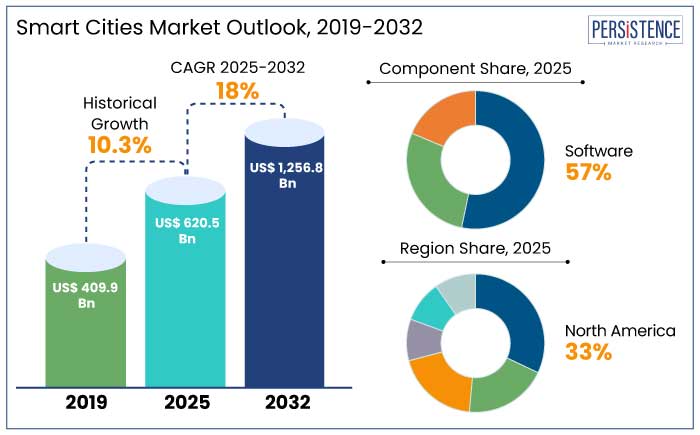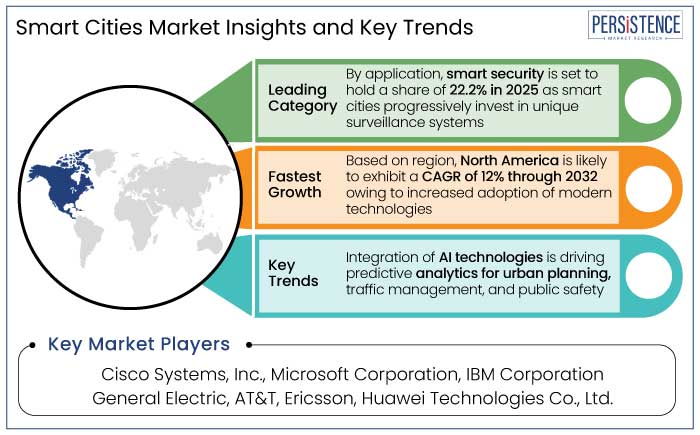Industry: IT and Telecommunication
Published Date: January-2025
Format: PPT*, PDF, EXCEL
Delivery Timelines: Contact Sales
Number of Pages: 194
Report ID: PMRREP12667
The global smart cities market is predicted to reach a size of US$ 620.5 Bn by 2025. It is anticipated to witness a CAGR of 18% during the forecast period to attain a value of US$ 1,256.8 Bn by 2032.
Smart cities aim to reduce carbon footprints through energy-efficient solutions, such as smart grids and public transportation systems. By 2030, around 60% of the global population is estimated to live in urban areas. This shift necessitates smarter infrastructure to handle increased demands for energy, water, and transportation.
IoT devices, AI, and 5G are enabling real-time data collection and processing, driving innovation in smart city solutions. Governments across the globe have increased funding and policies to promote sustainable urban development. For example,

Key Highlights of the Industry
|
Market Attributes |
Key Insights |
|
Smart Cities Market Size (2025E) |
US$ 620.5 Bn |
|
Projected Market Value (2032F) |
US$ 1,256.8 Bn |
|
Global Market Growth Rate (CAGR 2025 to 2032) |
18% |
|
Historical Market Growth Rate (CAGR 2019 to 2023) |
10.3% |
North America smart cities market is estimated to hold a share of 33% in 2025. Governments in the U.S. and Canada have allocated significant funds for smart city initiatives with a focus on modernizing urban infrastructure. For example,
North America leads in the adoption of cutting-edge technologies like IoT, AI, 5G, and cloud computing, which are crucial for smart city applications. By 2032, around 75% of urban areas in North America are predicted to integrate IoT-based solutions for traffic, energy, and public safety. Smart city solutions in North America prioritize energy efficiency, renewable energy adoption, and carbon footprint reduction. For instance,
Software is anticipated to hold a share of 57% in 2025. It acts as the foundation for integrating hardware and services, ensuring seamless operation of urban infrastructure.
Software facilitates communication between IoT devices, sensors, and platforms, enabling real-time monitoring and management. AI and big data analytics are integral to managing complex urban systems, from traffic to energy distribution. For instance,
Cloud computing enables cities to store and process massive volumes of data generated by IoT devices, improving scalability and efficiency. As urban systems become increasingly interconnected, software solutions for cybersecurity are essential to protect sensitive data and infrastructure.
Smart security is projected to account for a share of 22.2% in 2025. Rapid urbanization has increased crime rates and security threats, posing a demand for smart security solutions. For instance,
AI-powered facial recognition and behavior analysis, combined with IoT-enabled sensors and cameras, improve the accuracy and efficiency of security systems. Smart cities are investing heavily in unique video surveillance systems to monitor public spaces and critical infrastructure. For example,
Potential growth in the global smart cities industry is predicted to be driven by integration of IoT-enabled devices, cloud computing, and AI. For instance,
Carbon-neutral cities are likely to gain prominence, with a focus on renewable energy, electric vehicles, and green infrastructure. The period is also predicted to witness enhanced focus on citizen engagement through mobile apps and real-time service platforms. For instance,

The smart cities market growth was robust at a CAGR of 10.3% during the historical period from 2019 to 2023. Government authorities worldwide made hefty investments in smart city projects.
Key technologies like IoT, 5G, and AI became integral to smart city ecosystems. Smart city initiatives also focused heavily on energy efficiency, waste management, and reducing carbon footprints. For example,
Launch of Smart Transportation and Mobility Solutions to Spur Demand
AI-driven traffic lights, sensors, and cameras are being integrated to monitor and manage traffic flow in real-time, decreasing congestion and optimizing traffic light patterns. These systems use data analytics to predict traffic patterns and make adjustments, improving travel time and reducing fuel consumption. For instance,
Integration of self-driving cars, buses, and trucks is revolutionizing urban mobility. Autonomous vehicles (AVs) decrease the need for personal car ownership, minimize road accidents, and contribute to better traffic flow. For example,
Smart transportation solutions provide better mobility for all urban residents, including those in underserved areas. They help improve public transportation networks while offering seamless integration of various transport modes. For instance,
Rapid Digitization of Infrastructure to Spur Demand
Smart buildings use digital technologies to optimize energy use, improve comfort, and enhance the management of facilities. These buildings integrate systems like smart HVAC, lighting, and security systems to automate operations and reduce resource consumption.
Building Management Systems (BMS) use IoT devices and sensors to monitor conditions in real-time and adjust settings like lighting and temperature accordingly. Smart grids incorporate unique metering, sensors, and real-time data analytics to manage and optimize the production, distribution, and consumption of electricity.
The digital infrastructure allows utilities to improve grid reliability, reduce energy loss, and increase the use of renewable energy sources. Energy storage systems, powered by big data and AI, predict and balance energy supply and demand, enhancing the resilience of power grids. For example,
Digital Divide and Infrastructure Gaps May Hamper Demand
In several region, rural areas lack the infrastructure to support fast internet connections or even basic broadband access, thereby creating a digital gap between urban and rural areas. Lower income communities even in urban areas might face high costs and limited availability of internet services, making access to smart city innovations difficult.
Rising Government Initiatives and Investments to Create Opportunities
Government authorities across the globe are launching national smart city programs to promote sustainable urbanization. These programs are focused on improving infrastructure, public services, and energy management, and public safety. For instance,
Emergence of Sustainability and Environmental Goals to Open the Door to Success
Adoption of solar power, wind energy, and other forms of renewable energy is a significant part of smart city initiatives. Cities are implementing solar-powered streetlights, solar rooftops, and wind farms as part of their environmental strategies to decrease dependence on fossil fuels and lower emissions.
The capacity of solar energy installations in smart cities is witnessing rapid growth. In 2021, solar power contributed to over 3% of global electricity generation and is set to account for 20% of global electricity by 2030. For instance,
Companies in the smart cities market are forming alliances with local governments, municipalities, and public entities to secure large-scale projects and funding. These partnerships assist in navigating regulatory landscapes while ensuring the successful implementation of smart city solutions.
Businesses like Cisco and IBM have partnered with local governments to implement smart city solutions, including smart traffic management, energy efficiency, and digital infrastructure. Collaborations with technology providers enables companies to integrate modern technologies like AI, IoT, cloud computing, and 5G in their smart city offerings.
Continuous investments in research and development enables companies to stay ahead of the curve. Threse innovations are often focused on enhancing sustainability, improving urban mobility, and optimizing resource management.
Recent Industry Developments
|
Attributes |
Detail |
|
Forecast Period |
2025 to 2032 |
|
Historical Data Available for |
2019 to 2023 |
|
Market Analysis |
US$ Billion for Value |
|
Key Regions Covered |
|
|
Key Market Segments Covered |
|
|
Key Companies Profiled in the Report |
|
|
Report Coverage |
|
|
Customization and Pricing |
Available upon request |
By Component
By Application
By Region
To know more about delivery timeline for this report Contact Sales

The market is anticipated to reach a value of US$ 1,256.8 Bn by 2032.
Its main goal is to optimize city functions and promote economic growth while improving the quality of life for citizens through the use of smart technologies and data analysis.
North America is anticipated to emerge as the leading region with a share of 33% in 2025.
Prominent players in the market include Cisco Systems, Inc., Microsoft Corporation, and IBM Corporation.
The market is predicted to witness a CAGR of 18% during the forecast period.